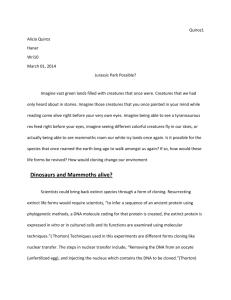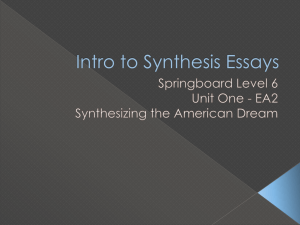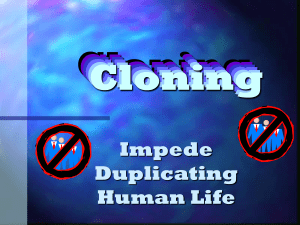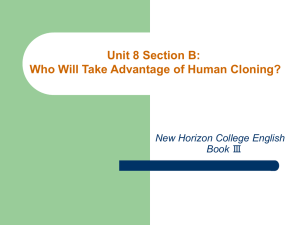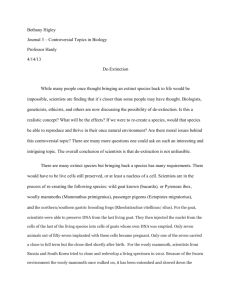Cloning Endangered Species
advertisement
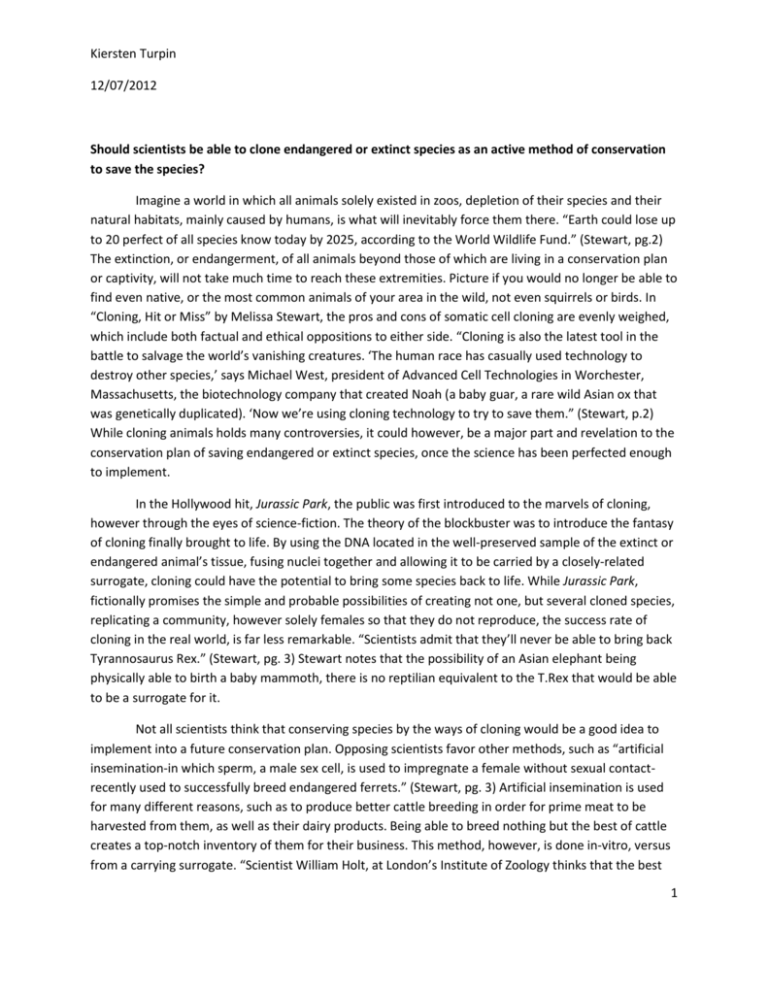
Kiersten Turpin 12/07/2012 Should scientists be able to clone endangered or extinct species as an active method of conservation to save the species? Imagine a world in which all animals solely existed in zoos, depletion of their species and their natural habitats, mainly caused by humans, is what will inevitably force them there. “Earth could lose up to 20 perfect of all species know today by 2025, according to the World Wildlife Fund.” (Stewart, pg.2) The extinction, or endangerment, of all animals beyond those of which are living in a conservation plan or captivity, will not take much time to reach these extremities. Picture if you would no longer be able to find even native, or the most common animals of your area in the wild, not even squirrels or birds. In “Cloning, Hit or Miss” by Melissa Stewart, the pros and cons of somatic cell cloning are evenly weighed, which include both factual and ethical oppositions to either side. “Cloning is also the latest tool in the battle to salvage the world’s vanishing creatures. ‘The human race has casually used technology to destroy other species,’ says Michael West, president of Advanced Cell Technologies in Worchester, Massachusetts, the biotechnology company that created Noah (a baby guar, a rare wild Asian ox that was genetically duplicated). ‘Now we’re using cloning technology to try to save them.” (Stewart, p.2) While cloning animals holds many controversies, it could however, be a major part and revelation to the conservation plan of saving endangered or extinct species, once the science has been perfected enough to implement. In the Hollywood hit, Jurassic Park, the public was first introduced to the marvels of cloning, however through the eyes of science-fiction. The theory of the blockbuster was to introduce the fantasy of cloning finally brought to life. By using the DNA located in the well-preserved sample of the extinct or endangered animal’s tissue, fusing nuclei together and allowing it to be carried by a closely-related surrogate, cloning could have the potential to bring some species back to life. While Jurassic Park, fictionally promises the simple and probable possibilities of creating not one, but several cloned species, replicating a community, however solely females so that they do not reproduce, the success rate of cloning in the real world, is far less remarkable. “Scientists admit that they’ll never be able to bring back Tyrannosaurus Rex.” (Stewart, pg. 3) Stewart notes that the possibility of an Asian elephant being physically able to birth a baby mammoth, there is no reptilian equivalent to the T.Rex that would be able to be a surrogate for it. Not all scientists think that conserving species by the ways of cloning would be a good idea to implement into a future conservation plan. Opposing scientists favor other methods, such as “artificial insemination-in which sperm, a male sex cell, is used to impregnate a female without sexual contactrecently used to successfully breed endangered ferrets.” (Stewart, pg. 3) Artificial insemination is used for many different reasons, such as to produce better cattle breeding in order for prime meat to be harvested from them, as well as their dairy products. Being able to breed nothing but the best of cattle creates a top-notch inventory of them for their business. This method, however, is done in-vitro, versus from a carrying surrogate. “Scientist William Holt, at London’s Institute of Zoology thinks that the best 1 Kiersten Turpin 12/07/2012 way is to learn more about species’ reproductive habits and to preserve habitats that foster natural breeding…” (Stewart, pg. 3) By studying the species in a protected environment does seemingly seem more of an ethical approach, the illegal poaching will quickly deplete the organisms of the study, since most do not fear a high-security refuge. Cloning still has not yet been perfected quite enough to where it has become an active method for serving in conservation plans. With Advanced Cell Technologies’ experiment on the baby guar in early 2001, scientists “fused 692 ox cells to cow eggs, but only 81 grew into blastocysts. Scientists kept some blastocysts to study: Of the 40 implanted into 32 surrogate cows, only 8 became pregnant, and only Bessie gave birth (Noah)”. (Stewart, pg. 2) Even though Noah was a success, he only lived for 2 days, and died of scours, a chronic diarrhea in livestock caused by an intestinal infection. If a farmer were to create an entire stock of cattle by the cloning method, and all of them have weak autoimmune systems, the simplest virus could outbreak all of the cattle, and more than likely kill all of the farmer’s cattle roughly at the same time. Like Noah, many of the cloned attempts seem to die of natural causes, “but some scientists suspect the cloning process could render animals more susceptible to disease”. (Stewart, pg. 3) Cloned animals lack genetic diversity that permits them to be able to fight off diseases, like a naturally reproduced and born animal would. “In 1999, it took scientists in Hawaii 274 tries to generate three cloned baby mice, and last year it took researchers in Japan 110 tries before a surrogate sow gave birth to Xena-the first cloned piglet.” (Stewart, pg. 3) With the extremely low success rate of cloning even the most common animals, such as mice, it has not been perfected enough to be implemented as an active form of conservation. “In time, cloning technology will undoubtedly improve, but some researchers think endangered species shouldn’t be cloned until the process is more reliable.” (Stewart, pg.3) Fusing cells from two different species often leads to huge mix-ups. Genes are activated or deactivated at the wrong time, and developmental stages become delayed. (Bethge, pg. 2) This particular scientists speaks of specifically her own findings in the difficulties of a successful cloning operation-all having the same last chapter ending in death. Utilizing the method of conservation that cloning could provide, would not only create the possibility of saving endangered species, but also bringing back species that have already become extinct. Cloning is the only way to revive extinct species. Being able to clone these mammals could unlock its ecology, and the reasons as to why it became extinct. Scientists are planning to clone the Wooly Mammoth in the next five years. “The wooly mammoth has been extinct for 10,000 years. But the recent find of an intact mammoth frozen in Siberia has led scientists to hope they may one day clone it-with an elephant as its surrogate mother”. (Stewart, pg. 7) Scientists of South Korea’s Sooam Biotech Research Foundation plan to implement the bringing back of the wooly mammoth have already had success with cloning several other species of animals. According to NewsFeed, “South Korean scientists have already cloned animals including a cat, dog, a pig, a cow, and a wolf.” (Grossman, pg. 1) The issues lying behind cloning an animal who’s DNA has been frozen for over 15,000 years, is that the DNA itself is often too far damaged to successfully replicate for the beginning processes of the creation. “First off, 2 Kiersten Turpin 12/07/2012 the material must be extracted from an animal that has been dead for a maximum or 5 days, or if longer, the animal must have been preserved by being frozen immediately after death to preserve its cellular integrity.” (Extinct Animal, pg.1) Pioneering more successful techniques specialized for cloning mammals from frozen soft tissue has been implemented in 2008 when a mouse was cloned from the cells of a mouse that had been cloned for 16 years. (Purewal, pg.1) Continuing this science would be able to permit future scientists to perfect these methods to implement it in an active plan for bringing back extinct species to further study them, ones that have not ever been studies by humans before. While the argument of cloning being a costly method to conservation, and the money could be used on other, more natural methods of preservation of habitats, once the science has been perfected, it could be more of an economical advantage in reducing the costs of preservation and regulation. “Some endangered animals, like pandas, are almost impossible to breed in captivity. Cloning could produce new animals more quickly”. (Stewart, pg. 6) Other arguments oppose the conservation of animals as weakly adapt as the Giant Panda. In an interview from The Guardian, Chris Packman was quoted, “We have to accept that some species are stronger than others. The panda is a species of bear that has gone herbivorous and eats a type of food that isn't all that nutritious, and that dies out sporadically. It is susceptible to various diseases, and, up until recently, it has been almost impossible to breed in captivity. They've also got a very restricted range, which is ever decreasing, due to encroachment on their habitat by the Chinese population. Perhaps the panda was already destined to run out of time.” (Benedictus, pg.1) Prioritizing what needs to be conserved the most/first, will be an argument difficult to resolve. “In some cases, it may be cheaper to save some DNA, and let a future, richer and perhaps more enthusiastic generation make its own copy of the species” (Bethge, pg. 2) Saving DNA from several, if not all possible species of animals that roam the Earth today, could lead to scientific advances of the future. While scientists today have to find frozen DNA in permafrost of arctic environments, or preserved mosquitoes containing a speck of DNA like in that of Jurassic Park, we could make it easier for the future, and more advanced, generations of scientists yet to come. “We should be focusing our conservation endeavors on biodiversity hotspots, spreading our net more widely and looking at good-quality habitat maintenance to preserve as much of the life as we possibly can, using hard science to make educated decisions as to which species are essential to a community’s maintenance.” (Beneditcus, pg. 2) We cannot solely focus on cloning or saving species that are only attractive to us, however what would be the most beneficial to the ecology of the bigger picture. Panda research has been a costly focus; however they are not a keystone species, which is viable for humans’ existence. The most strongly driven and ethical argument opposing cloning would have to be, “scientists try to play God”, and that endangered animals should be left to extinction as it is in nature’s plan. “A wide variety of genes increases the odds that a species will thrive in its environment. A cloned animals DNA derives from a single animal. In the long run, the lack of genetic diversity may spell trouble for endangered species.” (Stewart, pg. 6) Some say that we are throwing off the earth’s natural balance by 3 Kiersten Turpin 12/07/2012 trying to save species, and that this was meant to happens. Even though humans have only been on the Earth for 200,000 years, we are the first to come up with the science and techniques as to try to “save” the Earth. While Earth is designed to process in cycles, and wipe out what does not survive through the process of natural selection, if we could devote our time here into perfecting a perfect balance in the human versus animal battle of survival, we would have at least succeeded in that. The Earth is made up of complex cycles, and to be able to bounce back; however it was not made for the extreme harvesting and depletion that we have caused it. We have set the Earth in a position that it cannot naturally recover from on its own. “We won’t be able to save it all, so let’s do the best we can”. (Beneditcus, pg. 2) Many scientists, just as well as the average public, feel that it is their obligation to do so, whether the methods of cloning for conservation lead us there or not. Works Cited Main article from EBSCOhost for argumentative points: Grossman, Samantha. Newsfeed. The Wooly Mammoth’s Return? Scientists Plan to Clone Extinct Creature. March 14, 2012. Article. Web. Supporting articles: Benedictus, Leo. The Guardian. Should Pandas be left to face extinction?. 22 Septermber 2009. Article. Web. Bethge, Phillip. Spiegel Online. Preservation in a Petri Dish: Scientists Hope Cloning Will Save Endangered Animals. Nov 11, 2012. Article. Web. Extinct Animal. 2002. March, 04, 2003. Web. Purewal, Sarah Jacobsson. Scientists to Clone Wooly Mammoth in Five Years. Jan 17, 2011. Article. Web. 4 Kiersten Turpin 12/07/2012 Stewart, Melissa. Science World. Cloning Hit or Miss? March 26, 2001. Vol 57. 12. Database. Masterfile Premier. 5

